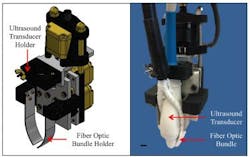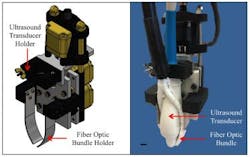Photoacoustic imaging system in development to improve disease diagnosis
Seeking to improve life-threatening disease diagnosis, researchers at Purdue University (West Lafayette, IN) are developing a bioimaging system that employs a noninvasive technique called photoacoustic tomography.
Photoacoustic tomography works by converting absorbed optical energy into acoustic signal. Pulsed light is sent into body tissue, creating a small increase in temperature that causes the tissue to expand and create an acoustic response that can be detected by an ultrasound transducer. The ultrasound data is then used to visualize the tissue.
"The nice thing about photoacoustic tomography is the compositional information," says Craig Goergen, an assistant professor in Purdue's Weldon School of Biomedical Engineering. "It provides information about where blood and lipid are located, along with other essential information."
The system provides real-time compositional information of body tissue without the need for contrast agents and with better depth penetration compared with conventional optical techniques. It can be used to detect or monitor several diseases, including cardiovascular disease, diabetes, and cancer.
Purdue University researchers are developing a novel biomaging system that combines optical and ultrasound technology to improve diagnosis of life-threatening diseases; they created a motorized photoacoustic holder that allows users to easily maneuver the fiber-optic bundles to tune the depth where light is focused, improving the light penetration depth and signal-to-noise ratio of the images. (Image credit: Purdue Research Foundation Image)
"That means there will be a great need for medical imaging. Trying to diagnose these diseases at an earlier time can lead to improved patient care," Goergen says. "We are in the process now of trying to use this enhanced imaging approach to a variety of different applications to see what it can be used for."
Among other potential uses for photoacoustic tomography is the mapping of lipid deposition within an arterial wall that can cause other health problems, measuring cardiac tissue damage and tumor biopsies. Using photoacoustic tomography for intraoperative tumor biopsies could help surgeons make sure they remove all the cancer from a patient, Goergen says.
One of the challenges of photoacoustic tomography is improving the penetration depth and signal-to-noise ratio past optical absorbers. The researchers believe creating optical manipulation techniques to maximize photon density could provide a solution. As a result, they have created a motorized photoacoustic holder that allows users to easily maneuver the aim of the device and tune the depth where light is focused, improving the light penetration depth and signal-to-noise ratio.
Full details of the work appear in the journal Photoacoustics.

